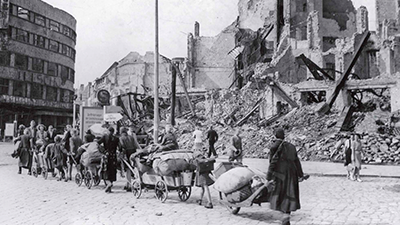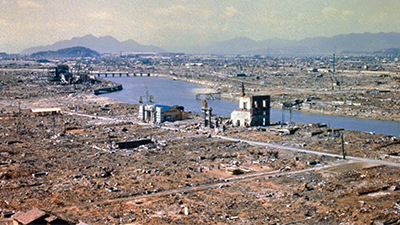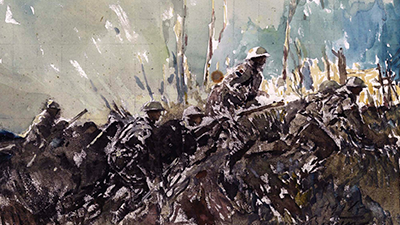The Cost of Global War
Teacher Resources
Driving Question: What were the consequences of World War II?
The cost of World War II can’t be measured in numbers alone. This lesson explores the human toll of global war and the birth of nuclear-age diplomacy.
Learning Objectives:
- Use the historical thinking practice of claim testing to evaluate global conflict.
- Use close-reading skills to analyze claims about the consequences of World War II and the dawn of a nuclear age.
- Understand the major economic, demographic, and political consequences of World War II.
Vocab Terms:
- authoritarian
- concentration camp
- fascism
- ideology
- militarism
- nuclear
- totalitarian
Opener: The Cost of Global War
To teach this lesson step, refer to page 2 of the Lesson 7.6 Teaching Guide.
The Second World War killed more people than any conflict in history. The voices of the survivors offer windows on the true cost of global war.
A Shattered World
To teach this lesson step, refer to page 3 of the Lesson 7.6 Teaching Guide.
See how other teachers use this video in the this thread, World War II.
Looking to change up the claim testing activity? Check out A Slightly Different Twist on Claim Testing – Global Conflict in the Community Forum.
World War II left behind devastation on a scale the world had never seen. With these materials, you’ll examine the staggering human cost of the war and explore the idea that the First and Second World Wars were part of a single, decades-long conflict.
-
Guiding Questions
-
Before you watch
Preview the questions below, and then review the transcript.
While you watch
Look for answers to these questions:
- How did military and civilian casualties differ during the war?
- Which country lost the most soldiers and civilians in the war, and why?
- Which side intentionally targeted civilians?
- Was World War II the deadliest war in history?
- What is meant by “The Long Peace”?
After you watch
Respond to this question: Why do you think major wars have become less frequent and less deadly since World War II?
Key Ideas
-
Guiding Questions
-
Before you read
Preview the questions below, and then skim the article. Be sure to look at the section headings and any images.
While you read
Look for answers to these questions:
- How did nationalism connect World War I and World War II?
- What roles did empires and colonialism play across both wars?
- How did the post–World War I treatment of Germany contribute to the outbreak of World War II?
After you read
Respond to these questions: Do you think viewing 1914 to 1945 as one long war helps us better understand the causes and consequences of global conflict? Why or why not?
The Bomb
To teach this lesson step, refer to page 8 of the Lesson 7.6 Teaching Guide.
Looking for supports to scaffold articles for your students? The OER Project Reading Guide provides a wealth of ideas.
The United States dropped two nuclear bombs on civilian cities. Were these attacks necessary to end the war?
-
Guiding Questions
-
Before you read
Preview the questions below, and then skim the article. Be sure to look at the section headings and any images.
While you read
Look for answers to these questions:
- How did nuclear science reach the United States before the bombs were developed?
- What is one argument for why President Truman decided to drop the atomic bombs?
- What alternative explanation does Gar Alperovitz offer for Truman’s decision?
- According to Hasegawa, what led Japan to surrender?
- Besides destruction, what other global consequences resulted from the development of nuclear weapons?
After you read
Respond to this question: Which explanation for the use of atomic bombs do you find most convincing, and why?
Closer: The Cost of Global War
To teach this lesson step, refer to page 9 of the Lesson 7.6 Teaching Guide.
Reflect on what you’ve learned about the costs the Second World War demanded from the world.
Art in a Time of War
To teach this lesson step, refer to page 10 of the Lesson 7.6 Teaching Guide.
The world wars didn’t just move borders—they changed how people saw the world. This article offers a creative lens to view how artists processed the loss, nationalism, and resilience that accompanied global conflict.
-
Guiding Questions
-
Before you read
Preview the questions below, and then skim the article. Be sure to look at the section headings and any images.
While you read
Look for answers to these questions:
- What was the purpose of Norman Lindsay’s Fight or Wait?
- What wartime experiences are reflected in Harding’s Traffic to Mont St. Pere and Harrison’s New Year, 1916?
- How did artists like Höch and Magritte respond to the trauma of the First World War?
- What was the goal of Riefenstahl’s Triumph of the Will?
- How do Maoist propaganda and El Salahi’s postcolonial art express different visions of postwar society?
After you read
Respond to this question: How does the artwork featured in this article help us understand the social and emotional impact of the two world wars?
Weapons and Warfare
To teach this lesson step, refer to page 11 of the Lesson 7.6 Teaching Guide.
This animated video from OER Project and Armchair Historian offers a fast-paced, visually engaging breakdown of World War II’s key military moments. It’s a chance to reinforce your understanding of the war's scale, timeline, and consequences in a format that truly illustrates some big connections.






